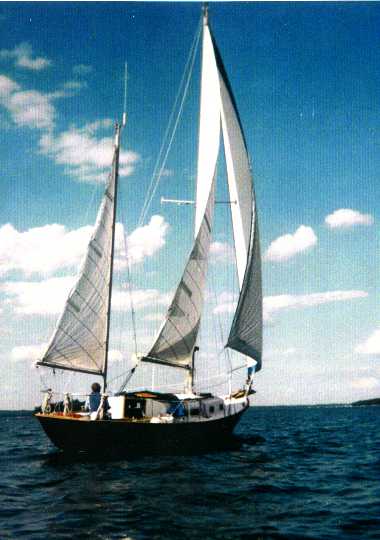Explaining "Step the Mizzen Mast . ."
I forget how much vocabulary we have picked up since we started sailing. Someone asks what does it mean to 'step the mizzen mast on a steel hulled yawl.'
A yawl is one of many styles of rigging a boat. What a rig is called depends upon the number of masts, the relative heights of each mast, the sails and placement of each on the boat. For a yawl, you have two masts: a main mast forward which carries the larger sail, and a mizzen mast further towards the stern which is usually smaller. The difference between a ketch (which is how Fiddler is set up) and a yawl is how far back the rear sail is relative to the rudder post. If the rear sail is in front of the rudder post, the boat is a ketch. If the rear sail is behind the rudder post, the boat is a yawl.
There are all sorts of other variations in sail plan which all have their own names. If that were not confusing enough, the individual sails have names depending upon the type of rig and where the sail is in the sail plan. It reminds me a little of learning all the names at a large family reunion. Trying to keep track of who is related to whom. I will see if I can find links or references to share.
Hull materials vary. The classic boat is wood planks attached to a wooden frame. Modern boats are often made of fiberglass, steel and even concrete as well as wood. While I expected US Naval vessels to be made of steel, I was a little surprised the first time I saw a steel hulled pleasure boat. The lines are a bit different, and the angles made by the plates gives the vessel a distintive look. I have yet to see a concrete boat that I am aware of, but I am assured they exist, and not just for the concrete conoe race (something like the Kinetics race.)
To step a mast is to place it into the socket made for it on the boat, frequently called "the mast step". On this particular boat, the mast step is a square socket that just fits the foot of the mast. When we arrived, the mizzen mast was laying out on the deck. The captain had taken the main sheet (the rope and block that control the main sail boom) and tied it on to the mizzen mast a bit above halfway up. This gave us a line to hoist the mast and control its descent into the step. We had five people: the captain and his wife, me and my husband, and the hand hired to run some of the electronics. With three down by the mast step, and two of us up on a work platform, we raised the mast from the deck until it was vertical, then lowered it down as the folks by the step guided the foot into the step. The recent rains had swollen the mast slightly, so it was a tight fit and took some fiddling to get it to go in.


1 Comments:
OK, I think that helps...a little... :-)
You know you're going native when the folks back home can't understand what you're saying...
Will be looking forward to your stories (mariner's dictionary firmly in hand)
Michelle
Post a Comment
<< Home